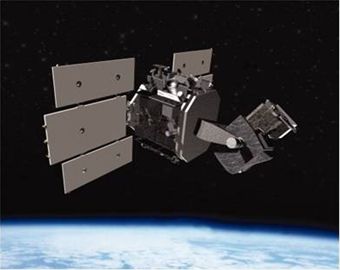DENYING SPACE
Society increasingly depends on the services provided by satellites. What if GPS and other services were unreliable or unavailable? Police, firefighters, and paramedics, who rely on satellite navigation, would be slow or unable to respond in an emergency. Live news from across the country or the other side of the planet would no longer be available. Long-distance telephone, satellite television, and internet would be unavailable. Retail stores and gas stations could not communicate with banks to complete transactions. Many critical services and daily conveniences we rely on could be affected by weapons targeting our space services.
Potential adversaries are developing and proliferating a variety of weapons that could disrupt or deny civil and military space services. Although many of these weapons are intended to degrade space services temporarily, others can damage or destroy satellites permanently.
Adversaries may jam global navigation and communications satellites used for command and control of naval, ground, and air forces, to include manned and unmanned vehicles. l Weapons designed to target intelligence, surveillance, and reconnaissance capabilities may deny the ability to locate, monitor, track, and target the enemy. For example, lasers can temporarily or permanently blind imagery satellites and other strategic sensors.
- Adversaries may use anti-satellite missiles to shoot down satellites in low Earth orbit. China used an anti-satellite missile against its own defunct weather satellite in 2007. The result of a missile shooting down a satellite can produce debris that may threaten satellites in nearby orbits.
- A number of foreign countries are believed to be testing on-orbit, space-based anti-satellite technologies and concepts. China and Russia continue to conduct sophisticated on-orbit activities that may advance counterspace capabilities.
- Physical attacks against ground sites and infrastructure that support space operations can also threaten satellite services. Cyber capabilities could target space systems and supporting infrastructure.
Space Situational Awareness
Terrestrial and space-based sensors search the sky for foreign satellites, chart their orbits, and determine the function and operational status. This is a continuous process, first in a sequence of steps that a potential adversary will use to target satellites, launch counterspace weapons, and assess the effectiveness of an attack. This image depicts the various categories of sensors used for space situational awareness (e.g., ground-based radars, telescopes, signals intercept antennas, and space-based sensors).
China and Russia both have large networks of ground-based sensors to monitor and target satellites. Some of these sensors also perform a ballistic missile early warning function.
Space object surveillance and identification sensors can also enable foreign denial and deception programs. For instance, knowing when reconnaissance and remote sensing satellites pass overhead allows adversaries to coordinate the concealment of sensitive military capabilities or operations on the ground.
Countries without advanced space tracking sensors can attain basic space situational awareness by purchasing commercially available telescopes.
Cyber and Electronic Threats
Satellite command and data distribution networks expose space systems, ground infrastructure, users, and the links connecting these segments to cyber threats. The graphic below indicates possible cyber threats to each of a space system’s segments.
Foreign competitors are capable of conducting electronic attacks to disrupt, deny, deceive, or degrade space services. Jamming prevents users from receiving intended signals and can be accomplished by two primary methods: uplink jamming or downlink jamming.
Uplink jamming is directed toward the satellite, and must operate at the same frequency and approximate power level as the target signals. Effects can be widespread. Conversely, downlink jamming is directed at users on the ground, and its effects are more localized.
China and Russia consider both offensive cyber capabilities and electronic warfare as key assets for maintaining military advantage. As a result, both countries are researching and developing cyber capabilities and modernizing electronic warfare assets.
Anti-Satellite Missiles and Directed-Energy Weapons
Anti-satellite missiles destroy targeted satellites. Using a ground-launched anti-satellite missile in 2007, China destroyed one of its defunct weather satellites more than 500 miles above the Earth. As seen below, the impact of this collision generated over 3,000 pieces of space debris that will continue orbiting the Earth for decades.
China has military units that have begun training with anti-satellite missiles. Russia is probably also developing an anti-satellite missile. These missiles can destroy U.S. and allied space systems in low Earth orbit, making intelligence, surveillance, reconnaissance, and communications satellites vulnerable.
Counterspace directed-energy weapons are designed to produce reversible or non-reversible effects against space systems by emitting highly focused radiofrequency or laser energy. Reversible effects include temporarily blinding optical sensors. Non-reversible effects include permanently damaging or destroying sensors or other satellite components.
Both China and Russia intend to field counterspace directed-energy weapons. Over the past two decades, Chinese defense research has proposed the development of several reversible and non-reversible counterspace directed-energy weapons. Russia is reportedly developing an airborne laser weapon system intended for use against space-based missile defense sensors.
Some spacefaring countries are testing or researching sophisticated on-orbit technologies for satellite servicing and debris removal. These technologies could also damage satellites.
SPACE OUTLOOK
Foreign space competitors will pursue new capabilities to access, operate in, and conduct war using the space domain, while working to deny the same to others. In the near future, competitors will enhance their warfighting capacity by improving space capabilities. Increasingly affordable space systems will heighten space congestion and raise the risk of collision. Development of some space technologies could lead to a misperception of intent, driving countries to adopt a more hostile posture. Understanding the risks created by emerging technologies is critical to maintaining a peaceful space domain.
New Competition for Space Beyond Earth’s Orbit
In the past two decades, foreign competitors have looked to lunar missions as key demonstrations of technological sophistication and economic prosperity. In 2013, China became the first country to land a mission on the Moon’s surface since the Soviet Union in 1976. China plans to become an international leader in lunar research and exploration with goals to assemble a lunar research station beginning in 2025, perform a crewed Moon landing mission in 2036, and establish a Lunar Research and Development Base around 2050. Russia plans to launch a robotic Moon mission in 2021.
China and Russia have active Mars and deep space exploration programs. Through the mid-2020s, China intends to launch its first Mars rover mission and an asteroid sample return mission. Russia’s Mars program can be traced back to Soviet ambitions in the 1960s. Since then, it has launched several Mars exploration missions, with the only two successful missions occurring in 1971. Recently, Russia has partnered with the European Space Agency in the European-led ExoMars program, which launched a Mars orbiter in 2016 and plans to launch a rover in 2020.
More Competitors will Integrate Space into Military Capabilities
Space-Based Weapons
Space-based anti-satellite systems are satellites that target other space systems. Concepts for space-based anti-satellite systems vary widely and include designs to deliver a spectrum of reversible and nonreversible counterspace effects. These concepts span from simple interceptors to complex space robotics systems, and can include kinetic kill vehicles, radiofrequency jammers, lasers, chemical sprayers, high-power microwaves, and robotic mechanisms.
China and Russia are the most capable competitors in space today. However, reduced cost, increased access, and proliferation of space systems will drive more countries to integrate these systems into military capabilities. Furthermore, commercial or openly available space-based intelligence, surveillance, and reconnaissance, communications, and navigation services may enable non-state actors (e.g., terrorist groups) to improve operational capabilities.
Growing Number of Space Objects will Increase Risk of Collisions
As the number of objects in space increases, particularly in low Earth orbit, the risk of collisions will grow. Amidst the growing popularity of smaller satellites, U.S. and allied space monitoring capabilities, which help prevent collisions in space, may struggle to track and identify objects and discriminate between threats and non-threats.
Increasing Use of Dual-Use Technologies Obscures Intent, Deterrence in Space
Dual-use capabilities will challenge U.S. ability to provide advanced warning of nefarious intentions or discern between peaceful and potential hostile activity. For example, future satellite servicing and recycling capabilities incorporate a variety of technologies, such as robotic arms, to inspect, repair, or dispose of damaged satellites. However, the same technologies have inherent counterspace capabilities that could be used to inspect non-consenting satellites or to cause physical damage, steal parts, or grapple with a satellite.
Future Concepts will Advance Space System Capabilities
Several concepts for future technologies promise to provide new enhancements to competitors’ space capabilities. For instance, advanced artificial intelligence and improved sensors will provide satellites the situational awareness for autonomous self-protection. Additionally, 3D printing in space could allow competitors to nearly eliminate the cost of space launch by servicing, repairing, or manufacturing new systems entirely on orbit.
Illustration:
The Space and Missile Systems Center at Los Angeles Air Force Base in El Segundo, Calif. is Air Force Space Command’s center of acquisition excellence for acquiring and developing military space systems. As the only active duty military installation in the greater Los Angeles metropolitan area, its portfolio includes the Global Positioning System, military satellite communications, defense meteorological satellites, space launch and range systems, satellite control networks, space based infrared systems and space situational awareness capabilities. (U.S. Air Force illustration)


